blog»Content Marketing»E-Commerce Marketing and A/B Testing Success: The Blue Apron Case Study
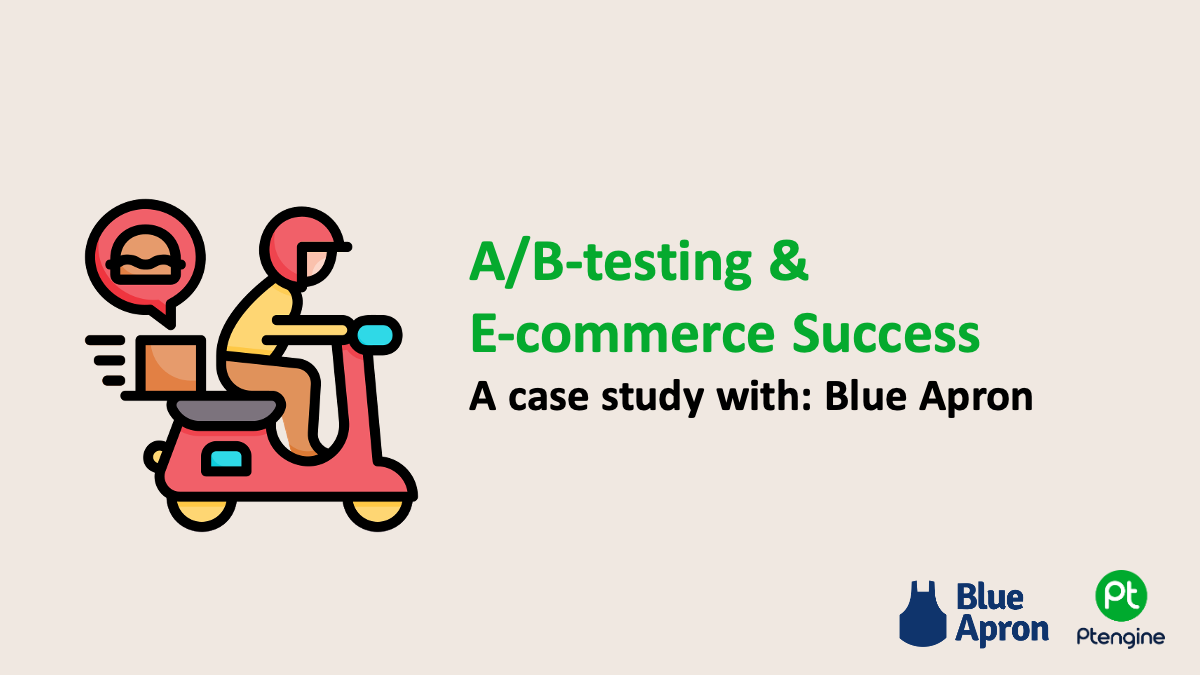
E-Commerce Marketing and A/B Testing Success: The Blue Apron Case Study
2024/07/02
You can read this article in about 28 minutes
Introduction
E-commerce is booming, and businesses are constantly finding new ways to attract and retain customers. One of the most effective strategies in this digital age is A/B testing. By experimenting with different versions of a webpage or marketing campaign, companies can determine what works best for their audience. This data-driven approach helps optimize user experience and boost conversion rates.
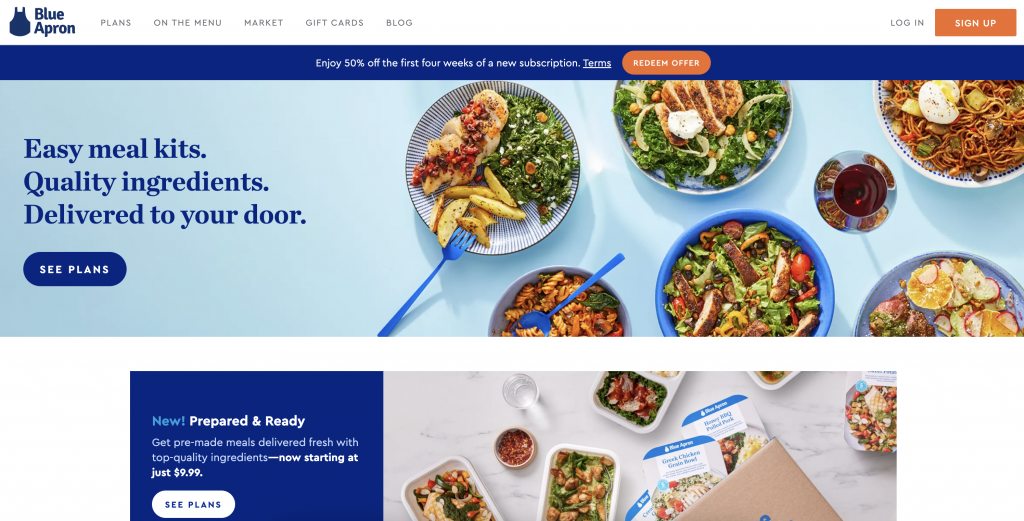
Blue Apron, a leader in the meal kit delivery industry, has mastered both e-commerce marketing and A/B testing. Their innovative strategies and relentless focus on customer satisfaction have propelled them to the top of the market. In this article, we’ll dive into how Blue Apron uses these tools to stay ahead of the competition and what lessons other businesses can learn from their success.
Section 1: The E-Commerce Landscape
E-commerce has seen explosive growth over the past decade. With more people shopping online than ever before, businesses are scrambling to capture a piece of this lucrative market. Everyone is leveraging digital platforms from small startups to giant retailers to reach their audience.
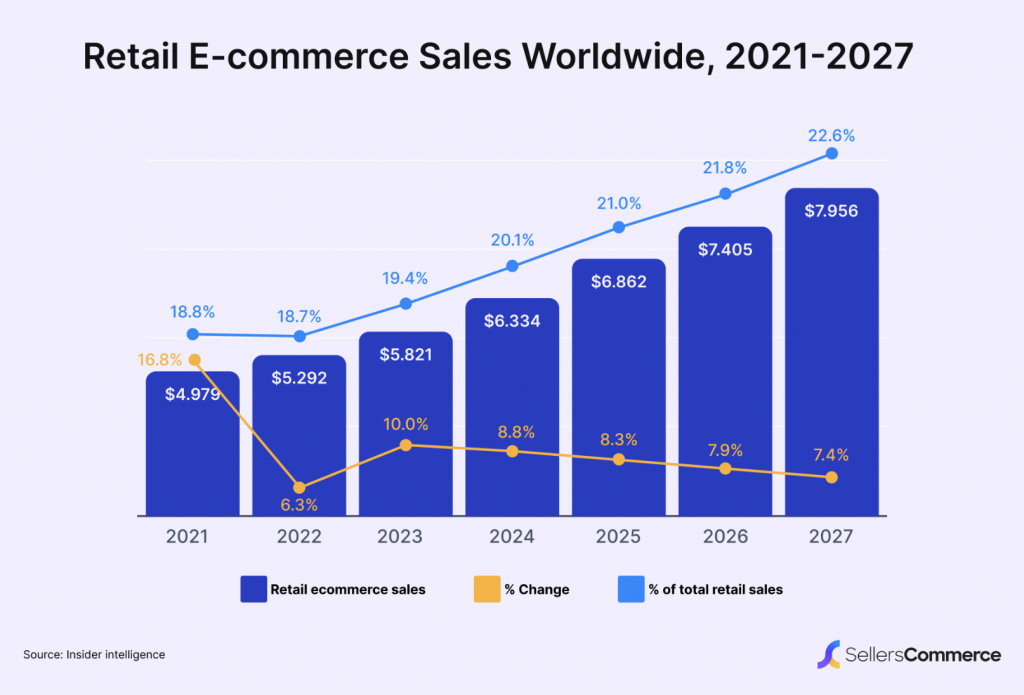
Digital marketing plays a crucial role in this ecosystem. Strategies like search engine optimization (SEO), social media marketing, and email campaigns help businesses attract and retain customers. The goal is simple: create a seamless, enjoyable online shopping experience that keeps customers coming back.
However, standing out in the crowded e-commerce space is no easy task. This is where A/B testing comes into play. Businesses can see what resonates best with their audience by running experiments on different versions of their web pages, emails, and ads. This data-driven approach helps them fine-tune their strategies, improve user experience, and ultimately increase conversions.
Successful e-commerce marketing is all about understanding customer behavior and preferences. Companies that can adapt quickly to changing trends and continuously optimize their digital presence are the ones that thrive. Blue Apron is a prime example of a company that has mastered this art, using A/B testing to stay ahead of the curve and deliver exceptional value to its customers.
Section 2: Introduction to Blue Apron
Blue Apron burst onto the scene in 2012, revolutionizing the way people cook at home. Founded by Matt Salzberg, Ilia Papas, and Matt Wadiak, this meal kit delivery service quickly became a household name. Their mission? To make incredible home cooking accessible to everyone, regardless of their culinary skills.

The concept is simple yet innovative. Blue Apron delivers fresh ingredients and step-by-step recipes straight to your door. This eliminates the hassle of meal planning and grocery shopping, making it easier for busy individuals and families to enjoy home-cooked meals. Customers can choose from a variety of meal plans tailored to their dietary preferences and schedule, ensuring flexibility and convenience.
Blue Apron’s business model centers around subscription services. Customers sign up for weekly deliveries, with the option to skip or cancel anytime. This model ensures a steady revenue stream while fostering customer loyalty. Additionally, Blue Apron focuses heavily on sustainability. They source high-quality ingredients from sustainable farms and fisheries, which appeals to eco-conscious consumers.
The company’s success has been remarkable. At its peak, Blue Apron was valued at $2 billion, reflecting its significant impact on the meal kit delivery industry. Over the years, Blue Apron has faced stiff competition from other meal kit services like HelloFresh and Plated. However, their commitment to quality, customer satisfaction, and continuous innovation has kept them at the forefront of the industry. They’ve also expanded their offerings to include wine pairings and kitchen tools, enhancing the overall customer experience.
In the competitive world of meal kits, Blue Apron stands out not just for their product but also for their marketing prowess. By leveraging data-driven strategies and constantly optimizing their approach, they’ve managed to build a strong brand and a loyal customer base.
Section 3: Blue Apron’s E-Commerce Marketing Strategies
Blue Apron has mastered the art of e-commerce marketing, employing a variety of digital tactics to attract and retain customers. Their approach is multifaceted, leveraging social media, email marketing, and content marketing to create a strong online presence and drive sales.
Social Media Marketing: Blue Apron actively engages with its audience on platforms like Instagram, Facebook, and Twitter. By sharing visually appealing photos of their meals, cooking tips, and customer testimonials, they create an interactive community around their brand. They also collaborate with influencers and run targeted ad campaigns to reach a broader audience. These efforts not only increase brand awareness but also drive traffic to their website.

Email Marketing: Email marketing is a cornerstone of Blue Apron’s strategy. They use personalized email campaigns to keep customers engaged, offering recipe suggestions, special promotions, and updates about new products. By segmenting their email list based on customer preferences and behavior, they ensure that their messages are relevant and timely, which helps in maintaining a high open and click-through rate.
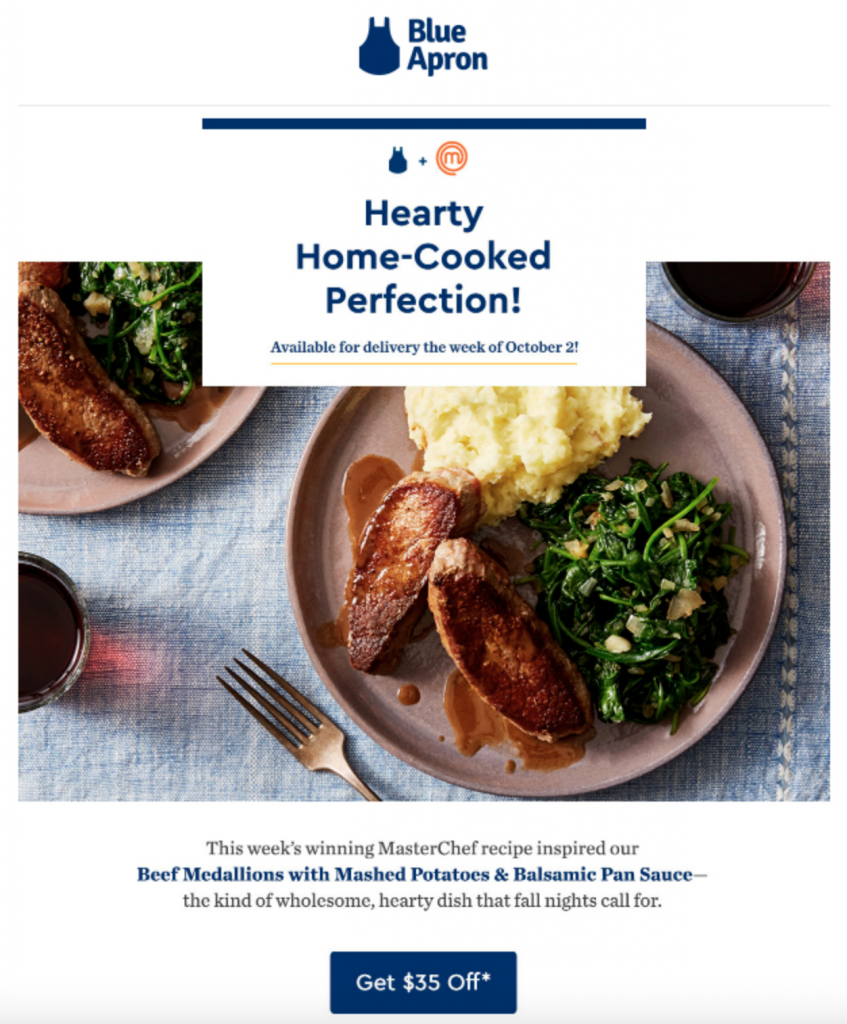
Content Marketing: Blue Apron’s blog and recipe section are rich resources for customers. They regularly publish articles on cooking techniques, ingredient sourcing, and meal planning tips. This content not only adds value for their existing customers but also attracts new visitors through organic search traffic. Additionally, they produce high-quality videos that demonstrate how to prepare their meals, making the cooking process approachable for everyone.
Search Engine Optimization (SEO): To capture search traffic, Blue Apron invests in SEO. They optimize their website content with relevant keywords, ensuring that potential customers can easily find them through search engines. Their efforts in local SEO also help them target specific regions, making it easier to tailor their marketing campaigns to different markets.
Paid Advertising: Blue Apron utilizes paid advertising on platforms like Google and Facebook to drive immediate traffic to their site. By using targeted ads and retargeting campaigns, they reach users who have shown interest in meal kits or related topics. This approach helps in converting potential leads into customers.

Customer Referral Programs: Word-of-mouth is powerful, and Blue Apron taps into this by offering referral programs. Customers who refer friends and family can earn discounts or free meals, incentivizing them to spread the word about Blue Apron. This not only helps in acquiring new customers but also rewards loyal ones.
A/B Testing: Blue Apron constantly tests different marketing messages, layouts, and promotions through A/B testing. This allows them to determine what resonates best with their audience and optimize their campaigns accordingly. Whether it’s a change in email subject lines or adjustments to their website design, A/B testing helps them make data-driven decisions to improve performance.
By combining these strategies, Blue Apron effectively markets its services to a wide audience, drives traffic to its website, and retains a loyal customer base. Their comprehensive approach to e-commerce marketing sets a strong example for other businesses looking to succeed in the digital marketplace.
Section 4: The Role of A/B Testing in Blue Apron’s Success
A/B testing is a critical component of Blue Apron’s marketing strategy, allowing the company to make data-driven decisions that enhance user experience and boost conversion rates. By testing different versions of their website, emails, and other digital assets, Blue Apron can identify what works best for their audience and continuously optimize their approach.
Website Optimization: Blue Apron frequently conducts A/B tests on various elements of their website, from homepage layouts to product page designs. For example, they might test different versions of a call-to-action button to see which one drives more sign-ups. These tests help ensure that every element of the site is optimized for maximum engagement and conversion.
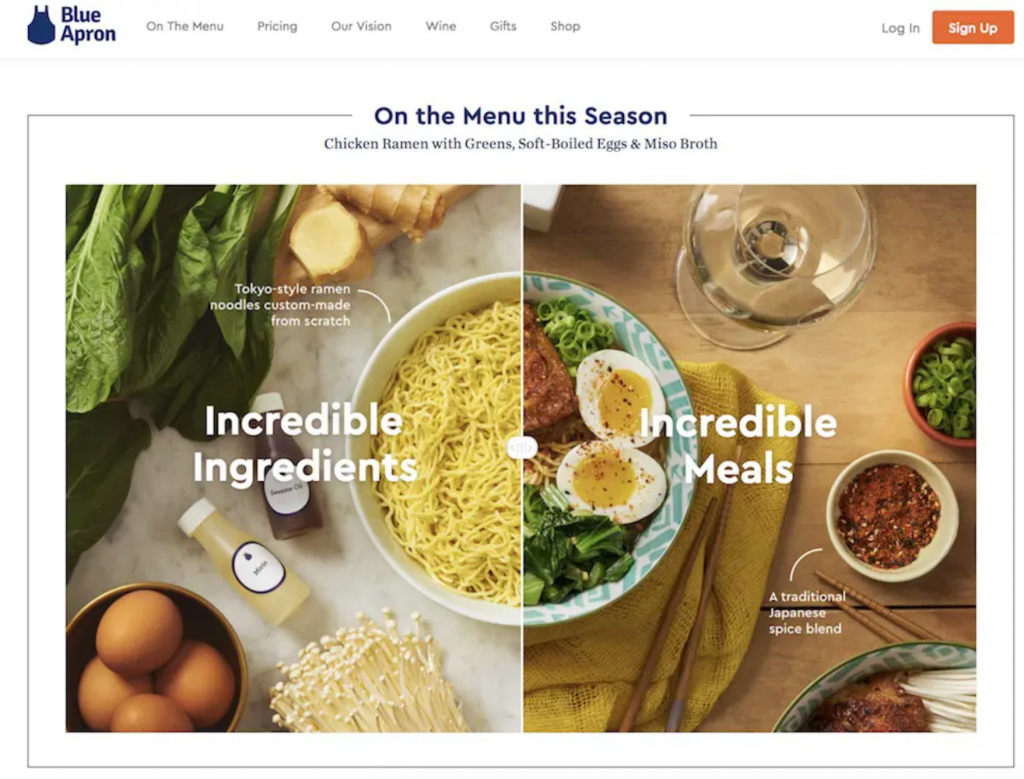
Email Campaigns: Email marketing is another area where A/B testing plays a vital role. Blue Apron tests different subject lines, email content, and send times to determine what resonates best with their subscribers. By analyzing open rates, click-through rates, and conversion rates, they can fine-tune their email campaigns to achieve better results.
User Experience Enhancements: A/B testing helps Blue Apron improve the overall user experience. They might test different navigation structures, checkout processes, or personalization features to see which versions users prefer. For instance, by simplifying the checkout process, they can reduce cart abandonment rates and increase completed purchases.
Promotional Offers: Blue Apron uses A/B testing to determine the most effective promotional offers. They might test different discount levels, free trial periods, or bundling options to see which ones drive the most conversions. This approach allows them to offer promotions that not only attract new customers but also retain existing ones.
Mobile Optimization: With a significant portion of their traffic coming from mobile devices, Blue Apron conducts A/B tests specifically for their mobile site and app. They test different mobile layouts, button sizes, and interactive elements to ensure a smooth and engaging experience for mobile users.
Personalization: Personalization is key to enhancing customer satisfaction. Blue Apron tests various personalized elements, such as recommended recipes based on past orders or tailored meal plans. By analyzing how these personalized features impact user behavior, they can create a more customized and appealing experience for each customer.
Section 5: Case Studies of Blue Apron’s A/B Testing Success
A/B testing has been instrumental in Blue Apron’s ability to fine-tune its marketing strategies and enhance user experiences. Let’s delve into some specific case studies that highlight their successful use of A/B testing.
1. Homepage Layout Optimization
Challenge: Blue Apron wanted to increase user engagement and conversions from their homepage.
Test: They tested two versions of their homepage: one with a prominent video showcasing meal preparation and another with static images. The hypothesis was that the video would be more engaging and convey the value of their service more effectively.
Result: The version with the video significantly increased user engagement, with visitors spending more time on the page and a higher percentage signing up for the service. This led to the implementation of video content as a key feature on their homepage.
2. Email Subject Lines
Challenge: Improving open rates for their marketing emails.
Test: Blue Apron tested different email subject lines, including personalized subject lines using the recipient’s name versus generic subject lines. The goal was to see if personalization would increase open rates.
Result: Emails with personalized subject lines had a noticeably higher open rate compared to generic ones. This insight helped Blue Apron refine their email marketing strategy, resulting in more effective communication with their subscribers.
3. Checkout Process Simplification
Challenge: Reducing cart abandonment rates during the checkout process.
Test: They tested two versions of the checkout process: a multi-step form versus a simplified, single-page checkout. The hypothesis was that a streamlined process would reduce friction and lead to higher completion rates.
Result: The simplified, single-page checkout process led to a significant increase in completed purchases. By reducing the number of steps and making the process more user-friendly, Blue Apron was able to decrease cart abandonment and boost conversions.
4. Promotional Offers
Challenge: Determining the most effective promotional offers to attract new customers.
Test: Blue Apron experimented with different promotional offers, such as percentage discounts, free meals, and free trial periods. They measured the impact of each offer on sign-up rates and customer retention.
Result: The tests revealed that offering a combination of a discount on the first few orders and a free trial period was the most effective in attracting new customers and encouraging them to stay. This combination provided immediate value and a low-risk way for new customers to try the service.
5. Mobile Site Optimization
Challenge: Enhancing the user experience on mobile devices.
Test: They conducted A/B tests on various elements of their mobile site, including navigation structures, button sizes, and interactive features. The goal was to make the site more intuitive and engaging for mobile users.
Result: Optimizations such as larger buttons and simplified navigation menus significantly improved the user experience on mobile devices. These changes led to increased mobile traffic and higher conversion rates from mobile users.
Conclusion:
These case studies illustrate how A/B testing has been a game-changer for Blue Apron. By continuously experimenting with different elements of their marketing and user experience, they have been able to make data-driven decisions that significantly impact their bottom line. These examples provide valuable insights for other e-commerce businesses looking to optimize their own strategies through A/B testing.
Section 6: Lessons Learned from Blue Apron’s Approach
Blue Apron’s success with e-commerce marketing and A/B testing offers several valuable lessons for other businesses looking to optimize their digital presence and drive growth. Here are some key takeaways from their approach:
1. Embrace Data-Driven Decisions
Blue Apron’s reliance on A/B testing highlights the importance of making decisions based on data rather than assumptions. By continually testing different elements of their marketing strategies and user interface, they can identify what works best and make informed changes. This approach reduces the risk of costly mistakes and ensures that every change is backed by evidence.
2. Optimize User Experience
User experience (UX) is at the heart of Blue Apron’s A/B testing efforts. From simplifying the checkout process to enhancing mobile site usability, every test aims to make the customer journey smoother and more enjoyable. Businesses should prioritize UX in their A/B testing to ensure that their websites and apps are intuitive, efficient, and engaging.
3. Personalize Marketing Efforts
Personalization has proven to be a powerful tool for Blue Apron, especially in their email marketing campaigns. By tailoring messages to individual customers based on their preferences and behavior, they can achieve higher engagement and conversion rates. Other businesses can benefit from using personalization to create more relevant and compelling marketing communications.
4. Test Everything, Big and Small
Blue Apron’s success shows that both major and minor changes can significantly impact performance. Whether it’s testing a new homepage layout or tweaking the color of a call-to-action button, every element should be considered for testing. This comprehensive approach ensures that no opportunity for improvement is overlooked.
5. Focus on Mobile Optimization
With a growing number of users accessing websites via mobile devices, optimizing for mobile is crucial. Blue Apron’s dedicated A/B tests for mobile site elements demonstrate the importance of providing a seamless mobile experience. Businesses should ensure that their mobile sites are just as user-friendly and efficient as their desktop versions.
6. Value Customer Feedback
In addition to quantitative data from A/B tests, qualitative feedback from customers can provide valuable insights. Blue Apron likely uses customer feedback to inform their testing hypotheses and understand the ‘why’ behind the data. Businesses should actively seek and incorporate customer feedback into their optimization efforts.
7. Continuous Improvement
A/B testing is not a one-time effort but an ongoing process. Blue Apron’s continuous experimentation and optimization illustrate the importance of regularly testing and iterating on marketing strategies and user interfaces. This commitment to continuous improvement helps businesses stay agile and responsive to changing customer needs and market conditions.

Conclusion
Blue Apron’s strategic use of A/B testing in their e-commerce marketing provides a roadmap for other businesses aiming to enhance their digital strategies. By embracing data-driven decisions, prioritizing user experience, personalizing marketing efforts, and continuously testing and optimizing, businesses can achieve significant improvements in performance and customer satisfaction. The lessons from Blue Apron’s approach serve as a valuable guide for any company looking to thrive in the competitive e-commerce landscape.4o